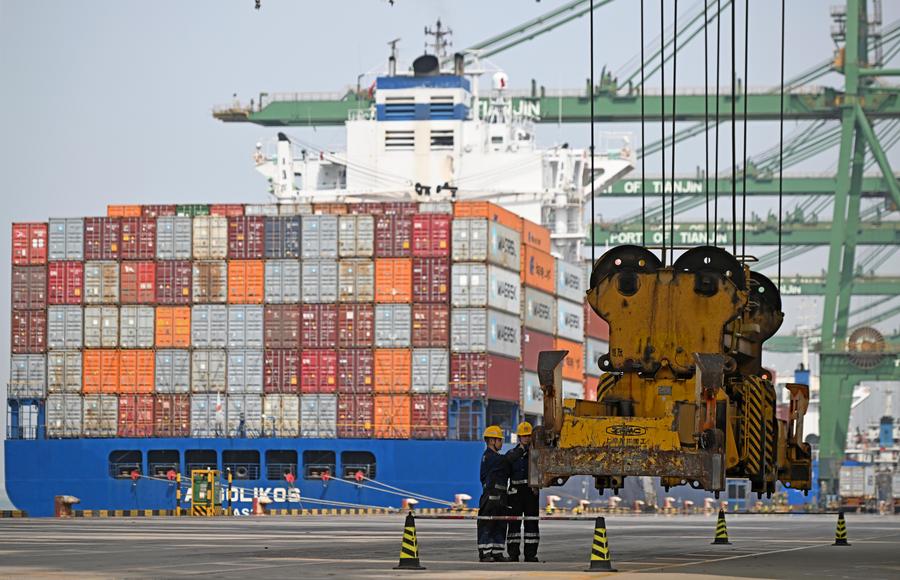The London Bridge: Moving Toward Trade Détente

History confirms that the trajectory of China-U.S. relations depends fundamentally on how both nations address each other’s concerns. When managed collaboratively, bilateral ties will flourish; when resorting to confrontation, they falter.
The inaugural session of the China-U.S. economic and trade consultation mechanism took place in London, the UK, on June 9-10. After two days of negotiations, both delegations reached consensus on a preliminary trade framework and submitted the outcomes to their respective heads of state for review. The framework will be implemented after getting approval from their respective leaders.
“The two sides have, in principle, reached a framework for implementing the consensus reached by the two heads of state during their phone call on June 5 and the consensus reached at the Geneva meeting,” said Vice Minister of Commerce Li Chenggang. During a high-level meeting in Geneva, Switzerland, on May 10, China and the U.S. agreed to greatly reduce the level of bilateral tariffs.
The latest round of China-U.S. economic and trade consultation has achieved tangible progress, which can in turn lead to increased bilateral trust. These developments not only lay the groundwork for more stable trade relations but also send a reassuring sign to the global economy. The international markets responded promptly to the consultation’s optimistic outcomes: On June 9, European and U.S. crude oil futures and securities markets rallied, demonstrating renewed investor confidence in the prospects of Sino-U.S. economic engagement.
The London talks have achieved a temporary easing of China-U.S. economic and trade relations, but whether the two sides can truly meet each other half way depends on the sincerity in the framework agreement’s implementation. Despite the positive attitudes of both sides, long-term conflicts such as technology competition and geopolitical differences still exist. In addition, the framework agreement is subject to approval from the leaders of the two countries, with specific clauses not yet disclosed at the time of writing.
Within the U.S. Government, divergent policy approaches toward China persist—particularly between the Department of Commerce and the Department of the Treasury—creating implementation uncertainties. Also, Washington’s strategic focus on constraining China’s technological advancement through its “small yard, high fence” tactic remains unchanged, mirroring enduring tensions beneath the surface of bilateral engagements.

In May, China’s exports to the U.S. fell 34.5 percent year on year, but its exports to the European Union and the Association of Southeast Asian Nations (ASEAN) increased by 12 percent and 14.8 percent, respectively, demonstrating the country’s ability to adjust trade fluctuations.
The U.S. cannot contain China through tariff measures. In fact, these policies are now backfiring, as seen in growing market volatility and a weakening U.S. dollar. Given these self-inflicted economic pressures, Washington must reassess the costs and benefits of its trade stance toward China. Reaching consensus with Beijing would help alleviate America’s domestic economic strains.
Decades of trade cooperation have created a complementary and mutually beneficial relationship between the two economies. For instance, while the U.S. runs a goods trade deficit with China, it maintains a services trade surplus—which reached $27.3 billion in 2024. This demonstrates how bilateral trade naturally balances across sectors, contrary to the one-sided narrative often emphasized by U.S. policymakers.
History confirms that the trajectory of China-U.S. relations depends fundamentally on how both nations address each other’s concerns. When managed collaboratively, bilateral ties will flourish; when resorting to confrontation, they falter.
The ongoing seven-year trade war has proven this axiom: U.S. unilateral trade restrictions have backfired, not just damaging Chinese businesses but also harming U.S. enterprises and consumers.
Dialogue and cooperation are the sole viable path forward for both nations. We remain convinced that when China and the U.S. work in concert, guided by the principles of equality, mutual respect and genuine cooperation, we can achieve steady and sustained progress in bilateral economic and trade relations.
For this partnership to flourish, we urge the U.S. to match its words with concrete actions. By faithfully implementing existing consensus and demonstrating good-faith efforts, both sides can preserve the hard-earned fruits of dialogue and return to a maintainable framework of mutual benefit. This is the only constructive way forward.
 Facebook
Facebook
 Twitter
Twitter
 Linkedin
Linkedin
 Google +
Google +










